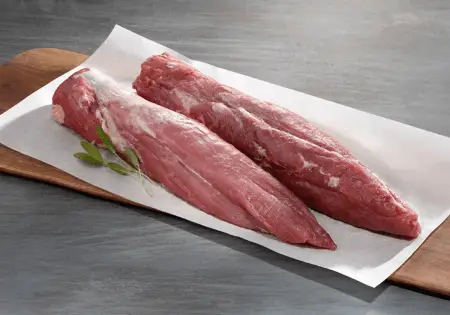When you go shopping, are you confused about which cut is pork loin and which is pork tenderloin? Imagine picking up one in the market only to find out that you need the other when you get home! This article seeks to explain the key differences between the two.
Summary Table
| Pork Loin | Pork Tenderloin |
| A cut below the pig’s shoulder going to its leg | A cut along the pig’s spine |
| Typically weighs 20 pounds | Usually weighs a pound |
| Inexpensive, lean meat with a fatty top layer | Expensive and relatively lean with no fat |
| Best grilled over medium heat | Requires hot, quick cooking |
Definitions

Pork loin is a large cut on either side of the animal’s back, starting from the shoulder and running to where the animal’s leg begins. The cut is usually boneless and is long and cylindrical in shape. A typical whole loin averages 20 pounds, and one end of the meat is always bigger than the other end. The cut is broken down further into the various chops and roasts available in the market. If the whole pork loin is cut into thirds, the center third can be boneless chops or steaks. The smaller end can be country-style ribs, and the larger end is typically pork sirloin roast
When a cookbook talks about a pork loin recipe, it often calls for a top loin roast. In terms of texture and flavor, pork loin is mildly flavored and is relatively lean with a thick layer of fat.
The meat turns white when cooked and is often recommended in low-fat diets. The thick, fatty layer retains the juicy flavor while cooking and can be trimmed off after cooking.
Keep in mind that some markets label this as a center-cut roast. It can be sold boneless, measuring 5 inches (12.
7 cm) across. It is also available bone-in, or with the backbone removed and the meat trimmed off of the ribs (i.
e. Frenched).

Pork tenderloin (i.e. pork tender, pork filet) is a small cut of lean meat from the muscle that runs alongside the pig’s backbone. It is a boneless cut, sold whole at an average weight of 1 pound and size of 10-12 inches long. Pork tenderloin is the most tender portion of pork because it is the least exercised part of the pig. This gourmet cut requires quick, hot cooking to produce that prized melt-in-your-mouth texture.
Pork Loin vs Pork Tenderloin
So what’s the difference between pork loin and pork tenderloin? Pork loin is a large cut of the animal’s back that runs from its shoulder down to its legs. Pork tenderloin is the most tender part, which runs along the sides of the spine.
Pork loin is a relatively lean piece of meat, topped with a layer of fat. It is sold boneless or bone-in. On the other hand, pork tenderloin has no fat and is boneless. In terms of cost, pork loin is one of the cheaper cuts of pig meat while pork tenderloin is one of the most expensive. Pork loin may be called “center cut pork loin roast,” “pork loin center,” or “pork loin center rib roast,” to name a few. Pork tenderloin is also known as “pork tender” or “pork filet.
“





